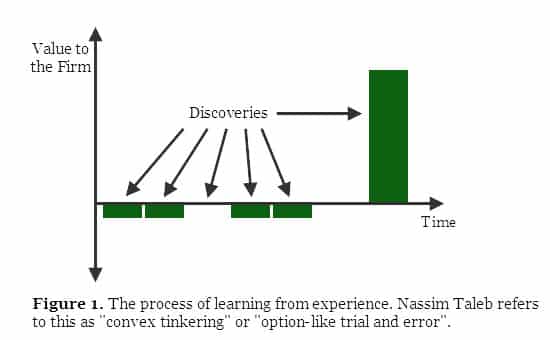Learning is a natural process, but management still has a role to play
(Source: Flickr)
FOLLOWING on from our post on learning from experience, in which we discovered that learning by doing is a natural process, we are finally delivering what we promised – a post which explores some ways that management can help.
Learning may occur naturally, but management can enhance and harness the learning process by:
- Fostering a culture of learning
- Directing effort to specific goals
- Capturing and sharing learning internally
- Keeping learning proprietary, and
- Commercialising good ideas
We explore each of these five approaches in more detail below.
1. Fostering a culture of learning
The culture of a firm can affect how receptive employees are to new ideas and the rate at which learning takes place. There are five methods that management can employ to help build a learning culture.
1.1. Create space for tinkering
If management wants to encourage improvement then a policy which punishes failure may sound like a good idea. Success is good, mistakes are bad, and therefore anyone who fails should be punished.
This may sound logical, but it ignores what we know about the learning process – mistakes are to be expected and are part of the natural process of learning which, combined with a due sense of stoic perseverance, inevitably leads to the next big breakthrough.
Scientists understand the learning process and have adopted trial-and-error as a fundamental part of the scientific method. Management needs to appreciate this as well.
Small mistakes and discoveries that lead nowhere are to be expected, and should not just be tolerated but accepted as normal.
If management tries to optimise operations and set deadlines so tightly that there is no space for curiosity and tinkering, then employees may be prevented from trying new approaches which have the potential to radically improve performance.
Intelligent and energetic people are more valuable when they have space to tinker. This fact has been willingly accepted by many Silicon Valley firms and was the core idea behind Google’s “20 Percent Time”, a company policy that allowed Google employees to spend one day per week on a project of their own choosing and which led to innovative new products like Gmail and Google Adsense.
1.2 Celebrate success
Incremental improvements and breakthrough advancements are valuable, and management can help by celebrating the employees responsible for making it happen.
Some people are motivated by short term monetary incentives, but when it comes to learning and creativity the process of discovery is often its own reward. By recognising the heroes, management can send a strong signal to everyone in the organisation that innovation is valued, and that the people responsible will be recognised.
The flip side of the coin is that new discoveries are often commercially sensitive, and so in order to protect innovations from the prying eyes of the competition it may be necessary to keep award ceremonies in-house and out of the media.
1.3 Measure Employee Engagement
Employees will only learn from experience if they are actually working – goofing around doesn’t count.
In a factory setting you can assess how much work is being done by measuring the factory’s output. This is easy to do.
The difficulty lies with professional service firms and other organisations where the work involves thinking and creativity. How can you tell whether people are really working? What if they are just going through the motions and filling out boilerplates without applying any independent thought? If this is the case, then they may not really be learning anything.
Our suggested solution to this problem is to measure employee engagement, for example using Gallup’s Q12 Survey. Employees who are more engaged in their work are more likely to be learning.
1.4 Temper Pride with Humility
A common way to boost morale is to encourage a feeling of pride in the organisation. This can be effective, and as you might remember your author’s high school headmaster was pretty fond of this technique, but it has a hidden cost.
As we explored in our post on humility, pride can blind us to the good ideas of others. A special fondness for your own organisation should not go so far as to blind you to the good ideas put forward by customers, suppliers, competitors, government agencies, universities, or your mother-in-law.
Don’t get too full of yourself.
1.5 Avoid Perverse Incentives
Perverse incentives are inducements which lead to unintended consequences, and management needs to be careful to avoid them.
One example given by behavioural economist Dan Ariely is the effect that small monetary payments can have on motivation.
Ariely explains that if you ask someone to help they may be quite willing to do so. However, if you offer them a small payment, say $10, then the person’s motivation is likely to decrease rather than increase.
The inducement has the opposite effect than intended because it crowds out the person’s internal motivation (i.e. the joy of helping), and transforms a social relationship into a financial transaction.
The offer of money changes the question that the person asks themselves from “Do I want to help Tom?” to “Is $10 fair payment for this job?”
According to Ariely, this problem can be avoided by offering a small gift instead of a small monetary payment. In other words, give chocolates or movie tickets to reward a job well done rather than offering a small hourly wage.
2. Directing effort to specific goals
Management guru Peter Drucker is famously quoted as saying “what gets measured gets managed”.
Making measurable progress is important, but before progress can be meaningfully measured management needs to set specific goals which employees can align their efforts around.
Undirected learning can be valuable especially during the early creative phase of product development, but in order to reach its destination the ship’s captain needs to set the sail.
Management needs to determine the direction of learning.
3. Capturing and sharing learning internally
To accelerate the learning process, a firm should establish ways to capture and share learning within and between practice groups, offices and business units.
Management should also be mindful of the fact that sharing information can be hindered by geographic distance and internal rivalry.
Ways of capturing and sharing learning include:
- Hold weekly team meetings at which learning points are discussed
- Record know-how by producing internal memos and technical papers
- Organise regular internal talks and conferences
- Support working groups that cut across formal departmental boundaries
- Send employees to external conferences and require them to share learning internally
- Acquire competitor learning by poaching employees, analysing competitor strategy, reverse engineering products, forming relationships with the competitor’s suppliers, and engaging consultants who have worked with the competition.
4. Keeping learning proprietary
If it is possible for a firm to learn from the competition, then it will also be possible for the competition to learn from it. This is a problem since it may allow competitors to improve performance more quickly and at lower cost.
Management should take steps to limit the spill over of learning to competitors, and ways of doing this include:
- Produce strategically important technology and components internally in order to maintain, develop and protect know-how
- Patent new technology in order to slow down the rate at which it can be copied
- Control publications and media releases to avoid educating the competition
- Retain key employees
- Place strict non-compete and non-disclosure provisions in employee contracts
5. Commercialising good ideas
Developing good ideas and new technology is important, but it is only half the battle. A firm also needs to develop a system for connecting innovations with commercialisation opportunities. Many large companies are currently doing this by running an in-house start up incubator that they use to generate, develop and commercialise good ideas.

